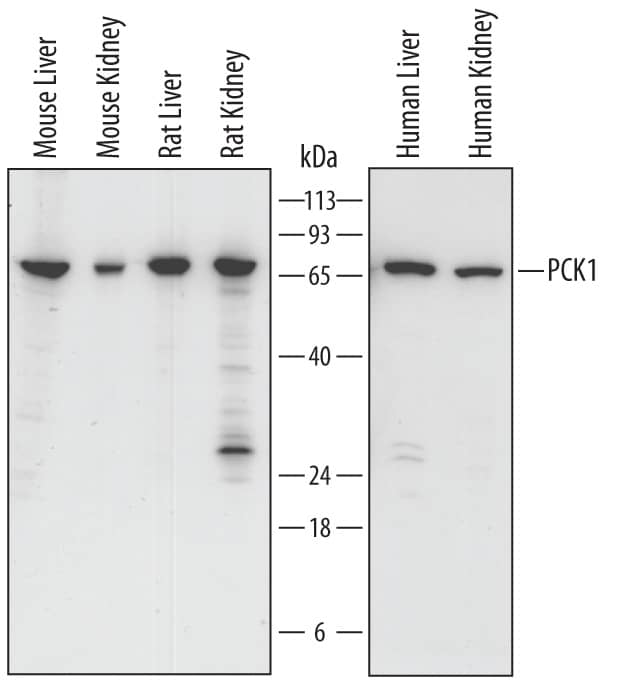Human/Mouse/Rat PCK1 Antibody
R&D Systems, part of Bio-Techne | Catalog # AF6787

Key Product Details
Species Reactivity
Applications
Label
Antibody Source
Product Specifications
Immunogen
Lys551-Met622
Accession # Q9Z2V4
Specificity
Clonality
Host
Isotype
Scientific Data Images for Human/Mouse/Rat PCK1 Antibody
Detection of Human, Mouse, and Rat PCK1 by Western Blot.
Western blot shows lysates of mouse liver tissue, mouse kidney tissue, rat liver tissue, rat kidney tissue, human liver tissue, and human kidney tissue. PVDF Membrane was probed with 0.2 µg/mL of Sheep Anti-Human/Mouse/Rat PCK1 Antigen Affinity-purified Polyclonal Antibody (Catalog # AF6787) followed by HRP-conjugated Anti-Sheep IgG Secondary Antibody (Catalog # HAF016). A specific band was detected for PCK1 at approximately 68 kDa (as indicated). This experiment was conducted under reducing conditions and using Immunoblot Buffer Group 1.Applications for Human/Mouse/Rat PCK1 Antibody
Western Blot
Sample: Mouse liver tissue, mouse kidney tissue, rat liver tissue, rat kidney tissue, human liver tissue, and human kidney tissue
Formulation, Preparation, and Storage
Purification
Reconstitution
Formulation
Shipping
Stability & Storage
- 12 months from date of receipt, -20 to -70 °C as supplied.
- 1 month, 2 to 8 °C under sterile conditions after reconstitution.
- 6 months, -20 to -70 °C under sterile conditions after reconstitution.
Background: PCK1
PCK1 (Phosphoenolpyruvate carboxykinase 1; also PEPCK-C [cytosolic]) is a monomeric, 67-68 kDa member of the PEP carboxykinase family of enzymes. It is expressed in postnatal cells such as mammary epithelium, white and brown adipocytes, skeletal muscle cells and hepatocytes. PCK1 has multiple functions, some of which are cell-specific. In particular, PCK1 has both cataplerotic (Greek: to fill down, or remove) and anaplerotic (to fill up, or replace) activity, where it removes and replaces elements of the TCA cycle. It is also gluconeogenic, and promotes glucose formation via PEP generation. Finally, it is glyceroneogenic, creating glycerol-3-phosphate that is used to reesterify and store just-released free fatty acids in adipocytes. Mouse PCK1 is 622 amino acids (aa) in length. It contains one kinase domain (aa 27-615), and two potential acetylation sites at Lys70 and 71. There are four potential splice forms. Two have alternative start sites at Met460 and Met315, while two others show a deletion of aa 34-546, plus a three aa substitution for aa 85-204, respectively. Over aa 551-622, mouse PCK1 shares 93% and 82% aa identity with rat and human PCK1, respectively.
Long Name
Alternate Names
Gene Symbol
UniProt
Additional PCK1 Products
Product Documents for Human/Mouse/Rat PCK1 Antibody
Product Specific Notices for Human/Mouse/Rat PCK1 Antibody
For research use only
